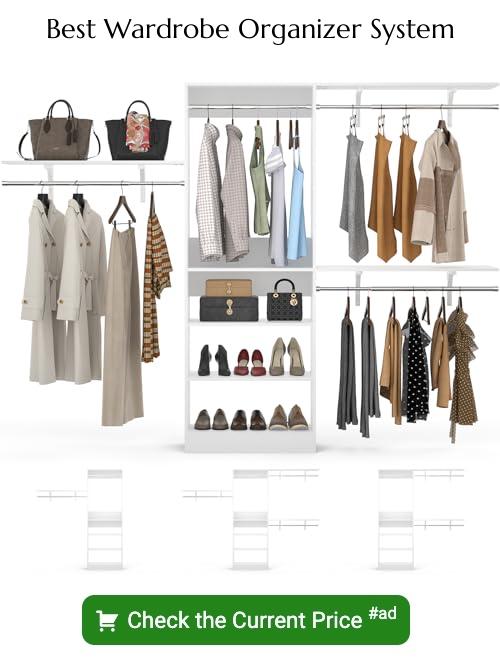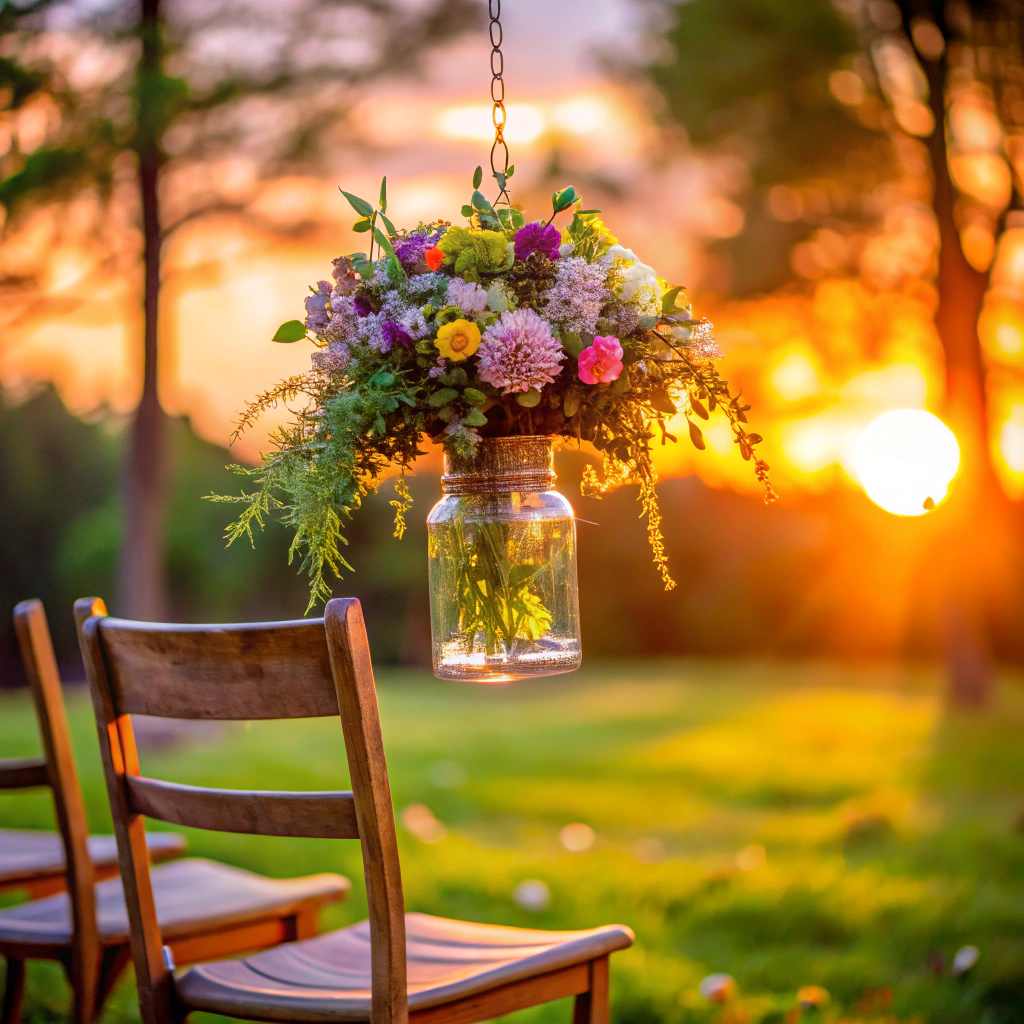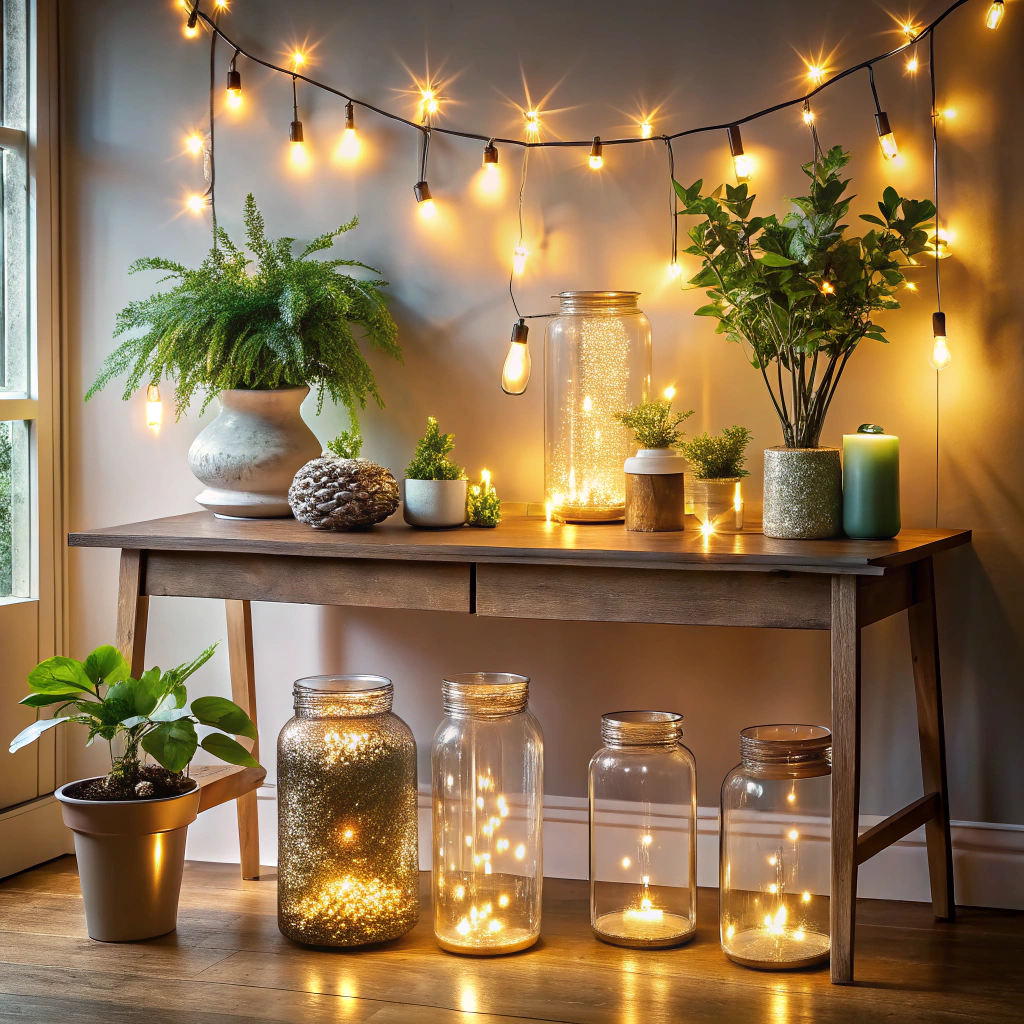Last updated on
Dive into the world of open closets because maximizing space while showcasing your style is the new trend in interior design.
Open closets are transforming how we interact with our wardrobe, offering a stylish and practical approach to clothing storage that harmonizes with modern living. Whether it’s simplifying your morning routine or showcasing your personal style, these wardrobe systems merge function with flair.
But with the variety of options, from customized hanging solutions to DIY shelving, diving into the world of open closets requires thoughtful consideration of your space, lifestyle, and preferences. This article offers a comprehensive guide to navigating the choices, ensuring you’ll find the perfect open closet setup that balances elegance with ease, without forgetting budget and maintenance factors like dust.
If you’re ready to revolutionize your clothing storage and display, let’s explore how to create an open closet that effortlessly aligns with your needs and aesthetic.
Key takeaways:
- Open wardrobes streamline morning routines and encourage organization.
- Assess space, organizational habits, design preferences, dust tolerance, and budget before choosing an open closet system.
- Customize hanging rods for efficient space utilization and accessibility.
- DIY shelving adds functionality and aesthetic charm to open closets.
- Shoe cubbies and accessory displays enhance organization and accessibility.
Benefits of an Open Wardrobe
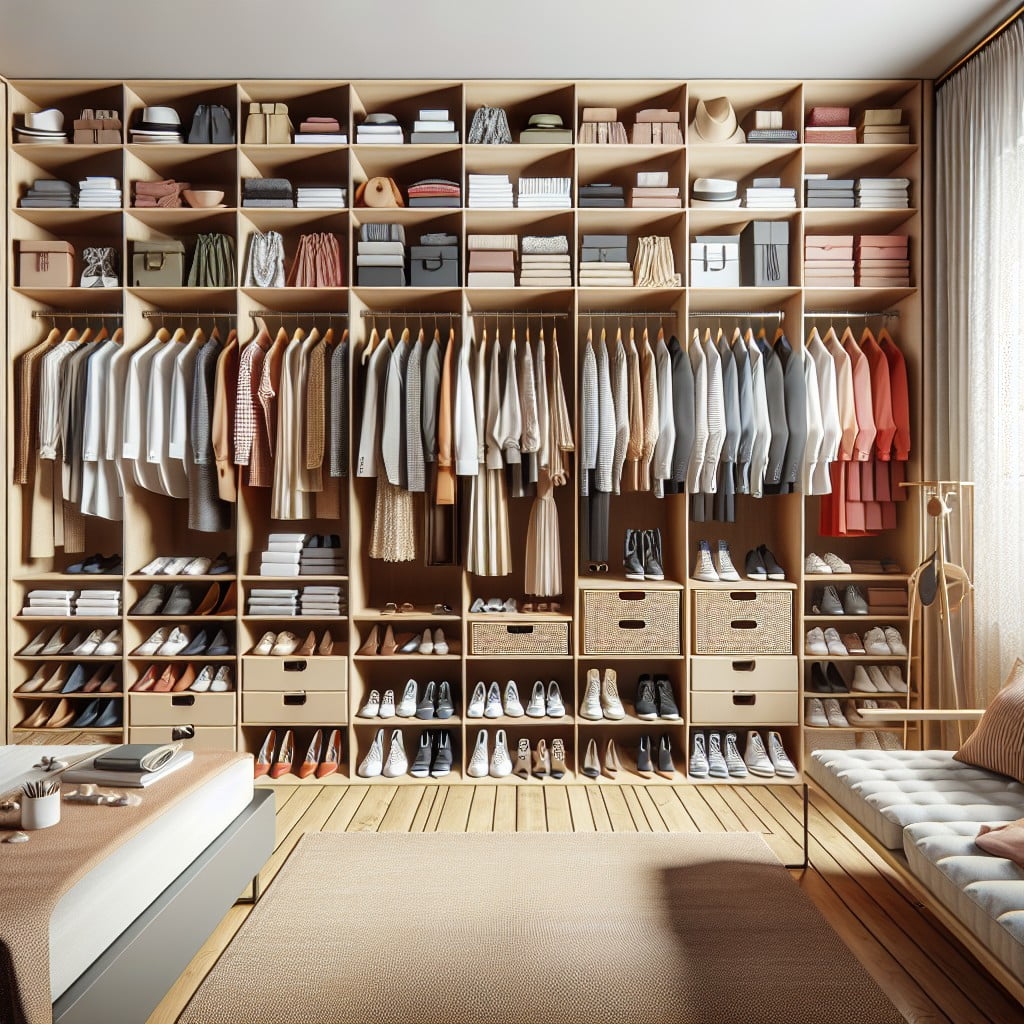
An open wardrobe invites ease of access, allowing you to view your entire clothing collection at a glance, which can streamline your morning routine and reduce time spent rummaging through drawers and doors. The visibility of items encourages organization, as clutter becomes immediately noticeable, prompting regular tidying. This system also promotes a minimalist lifestyle, as the open structure subtly encourages keeping only what you need and love.
Additionally, open closets can make a small space feel larger due to the absence of bulky doors or panels. They offer the flexibility to adapt to different spaces and can evolve with your personal style and storage needs. With the proper care, an open wardrobe can serve as a functional and stylish exhibition of your personal fashion.
Are Open Closet Systems Right for Me?
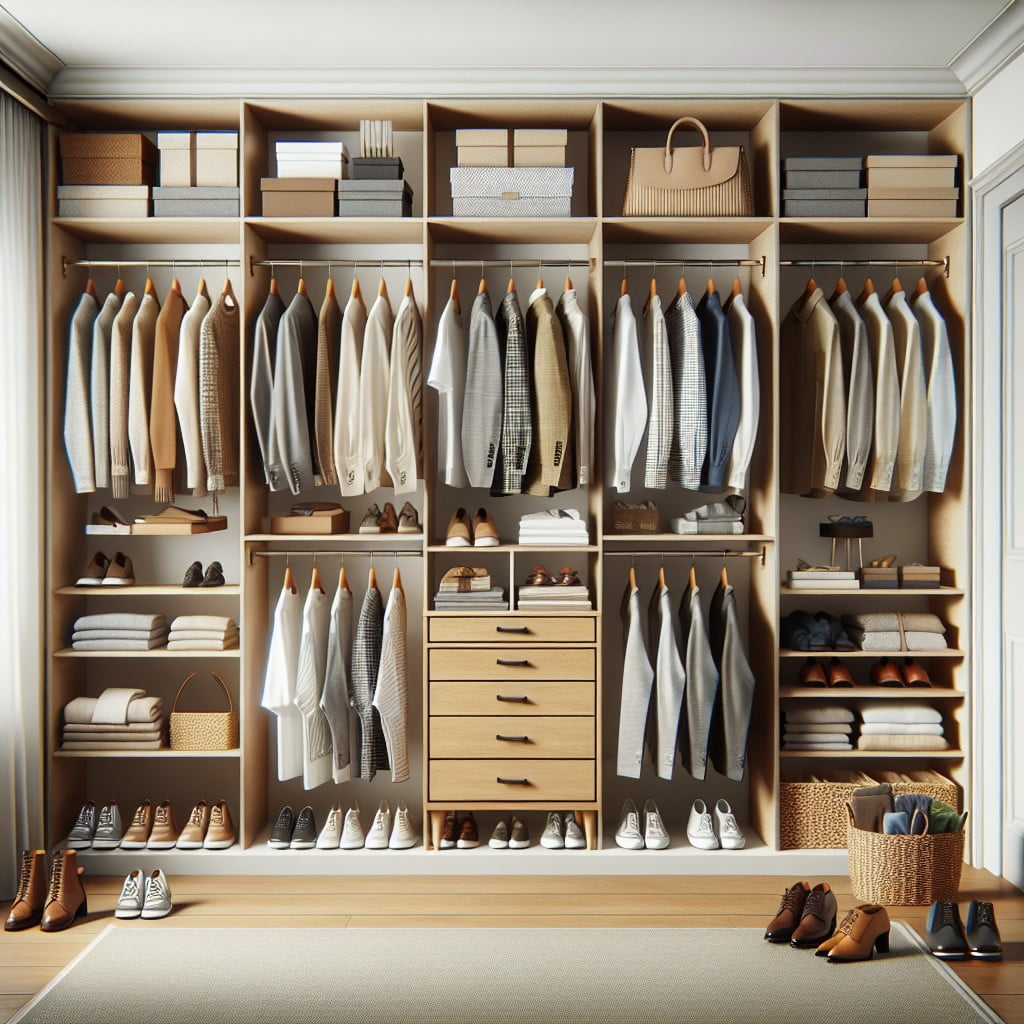
Determining if an open closet system suits your lifestyle involves assessing several factors:
- Space Considerations: These systems work best in generous spaces but can also create the illusion of more room in smaller areas due to their minimalistic design.
- Organizational Habits: If you’re meticulous about organization, an open system can display your wardrobe attractively. However, those who are less tidy might find it challenging to maintain an orderly appearance.
- Design Preferences: Do you appreciate modern, airy aesthetics? Open closets can integrate seamlessly into contemporary decor and provide a showcase for your fashion pieces.
- Dust Tolerance: Without doors to protect items, clothing is more exposed to dust. It’s important to weigh if the increased need for maintenance is a potential drawback.
- Budget Flexibility: These systems can be cost-effective, as they often require fewer materials than traditional wardrobes, yet the cost can rise with the addition of specialized organizers or high-end finishes.
By considering these points, you can make an informed decision on whether an open closet enhances both the functionality and style of your living space.
Customize Your Hanging Rods
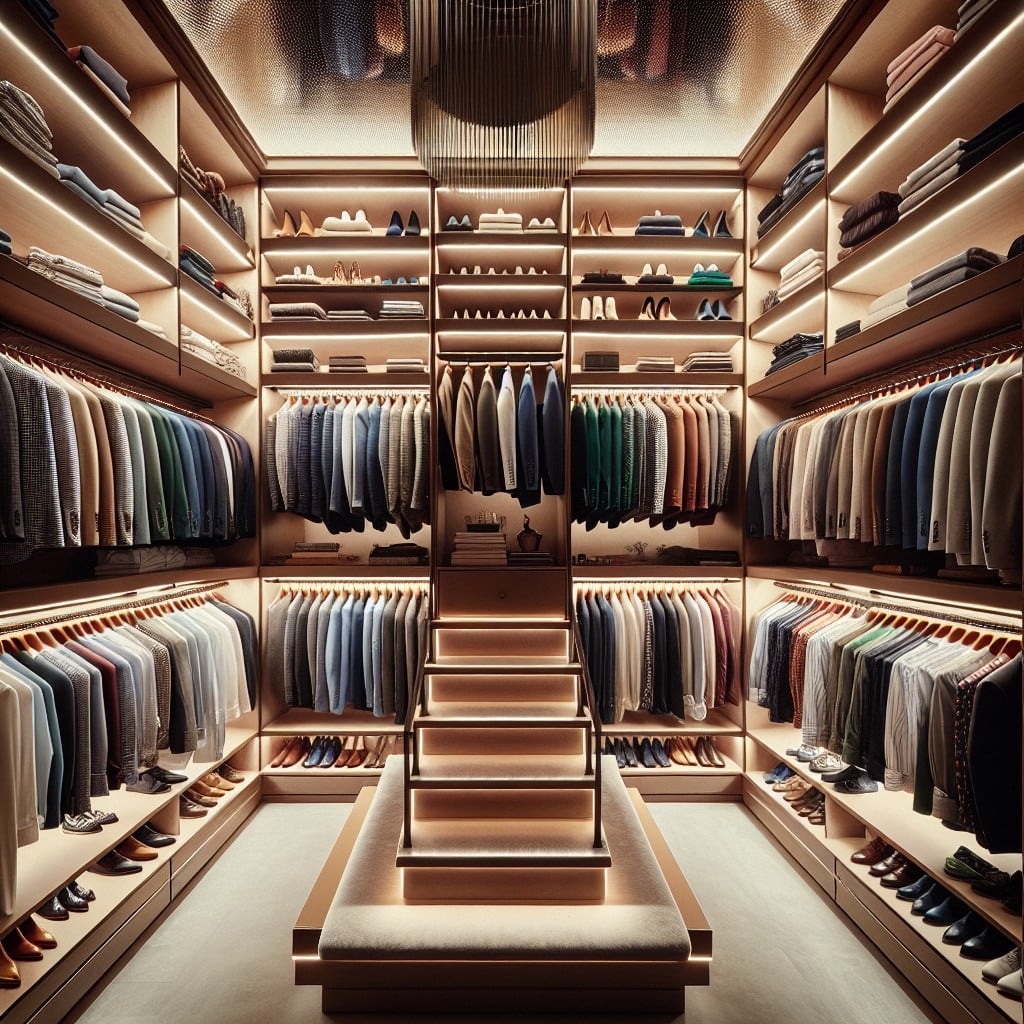
Maximizing vertical space is key. Utilize adjustable hanging rods to accommodate items of varying lengths, ensuring both long coats and short jackets find a home. For added versatility, consider installing multiple rods at different heights to separate types of clothing.
Incorporate different materials to match your decor. Choose from sleek metal for a modern touch or warm wood for a cozy, rustic appeal. The strength of the material is just as crucial; thicker rods are essential for heavier items to prevent sagging over time.
Think about visibility and accessibility. Position rods at eye level for frequently used items, and higher up for out-of-season or less commonly worn pieces. This keeps your day-to-day wear within easy reach while maintaining an organized layout.
Spacer rings or dividers can be a handy addition. These simple accessories help maintain even spacing between hangers, preventing overcrowding and ensuring each piece of clothing remains wrinkle-free and ready to wear.
Consider the use of pull-down rods for high spaces. These special fittings are especially useful for maximizing storage in tall closets, making it easy to access items stored up high with a simple pull.
Add DIY Shelving
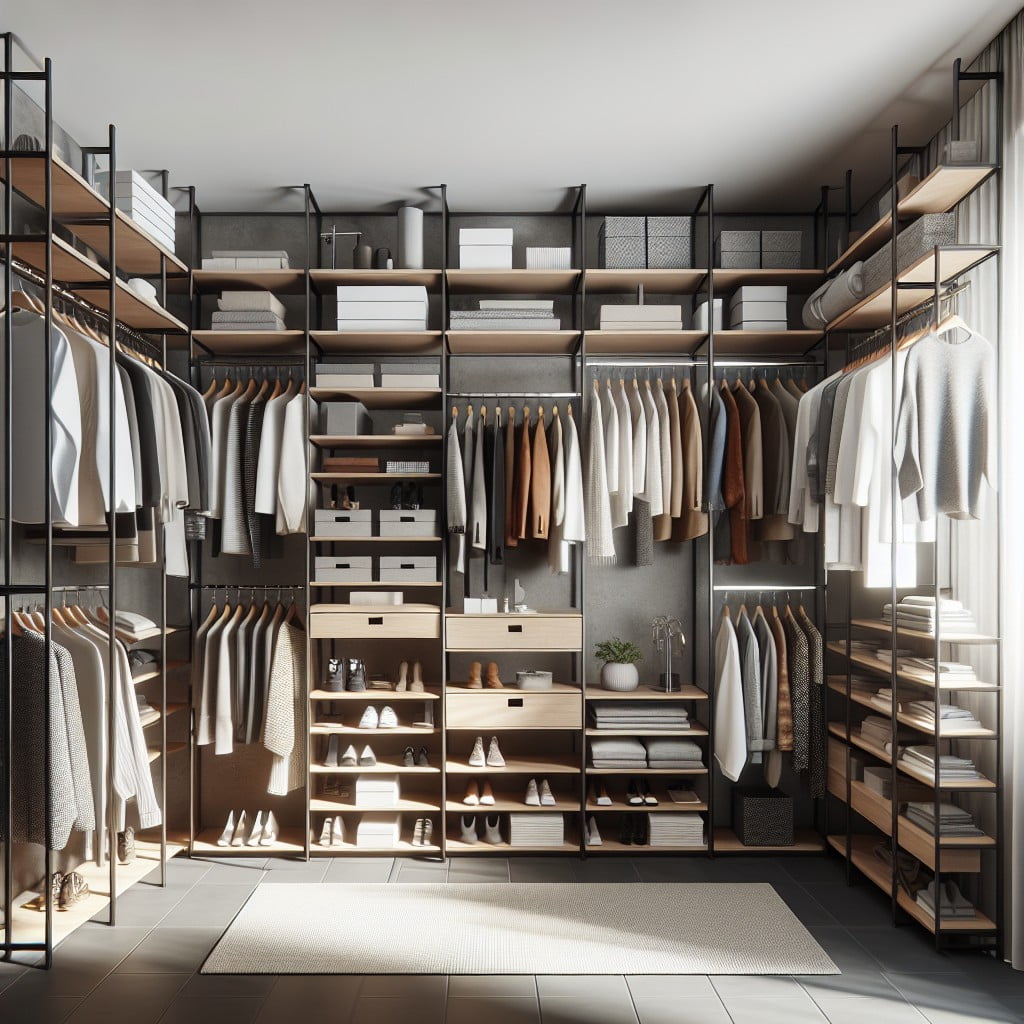
Integrating DIY shelving into your open closet design brings both aesthetic charm and functionality. By choosing your own materials, you can ensure shelves match your room’s decor. Here’s how to enhance your storage with just a few simple steps:
1. Measure Your Space: Take precise measurements to optimize every inch for an organized look and to avoid wasted space.
2. Select Your Materials: Whether it’s polished wood for a classic touch or industrial pipes for a modern edge, choose durable materials that reflect your style.
3. Mount Securely: Use appropriate brackets and wall anchors to ensure your shelves can hold the intended weight without sagging or collapsing.
4. Arrange Strategically: Place items you use frequently at eye level for easy access, and less used items higher up.
Remember, the key is to create a system that serves your unique needs while enhancing the overall appearance of your open closet.
Add Shoe Cubbies
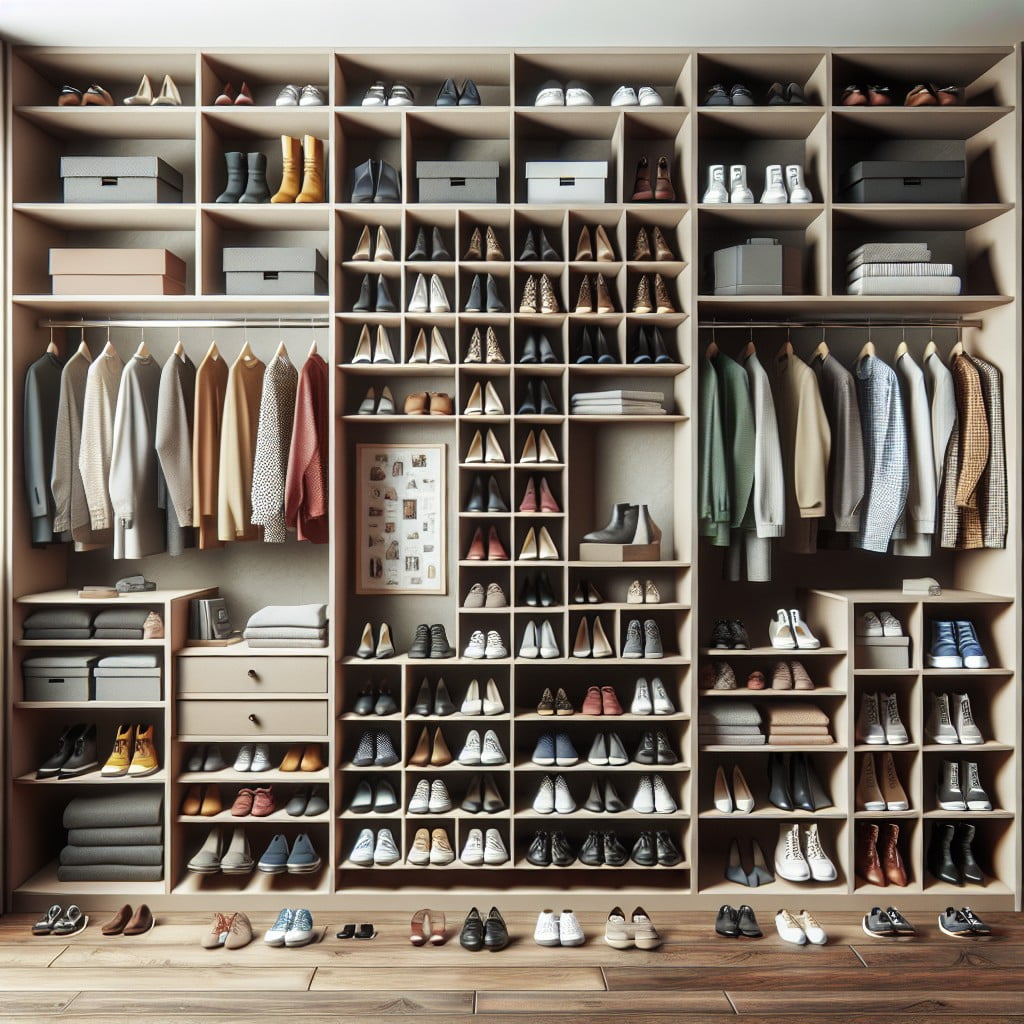
Incorporating shoe cubbies into your open closet elevates both organization and accessibility. By designating specific compartments for each pair, you streamline the search for footwear while also maintaining a visually orderly space.
Opt for adjustable dividers, allowing you to customize the cubby sizes based on your shoe collection, from slim sandals to bulky boots. Not only does this prevent piles of shoes from accumulating at the bottom of your closet, but it also keeps them in good shape, away from potential damage.
For a personal touch, consider using baskets or colorful boxes within the cubbies to add a pop of style and keep dust away. Embrace vertical space by stacking cubbies, which maximizes storage potential without expanding the closet’s footprint.
Highlight Your Accessories
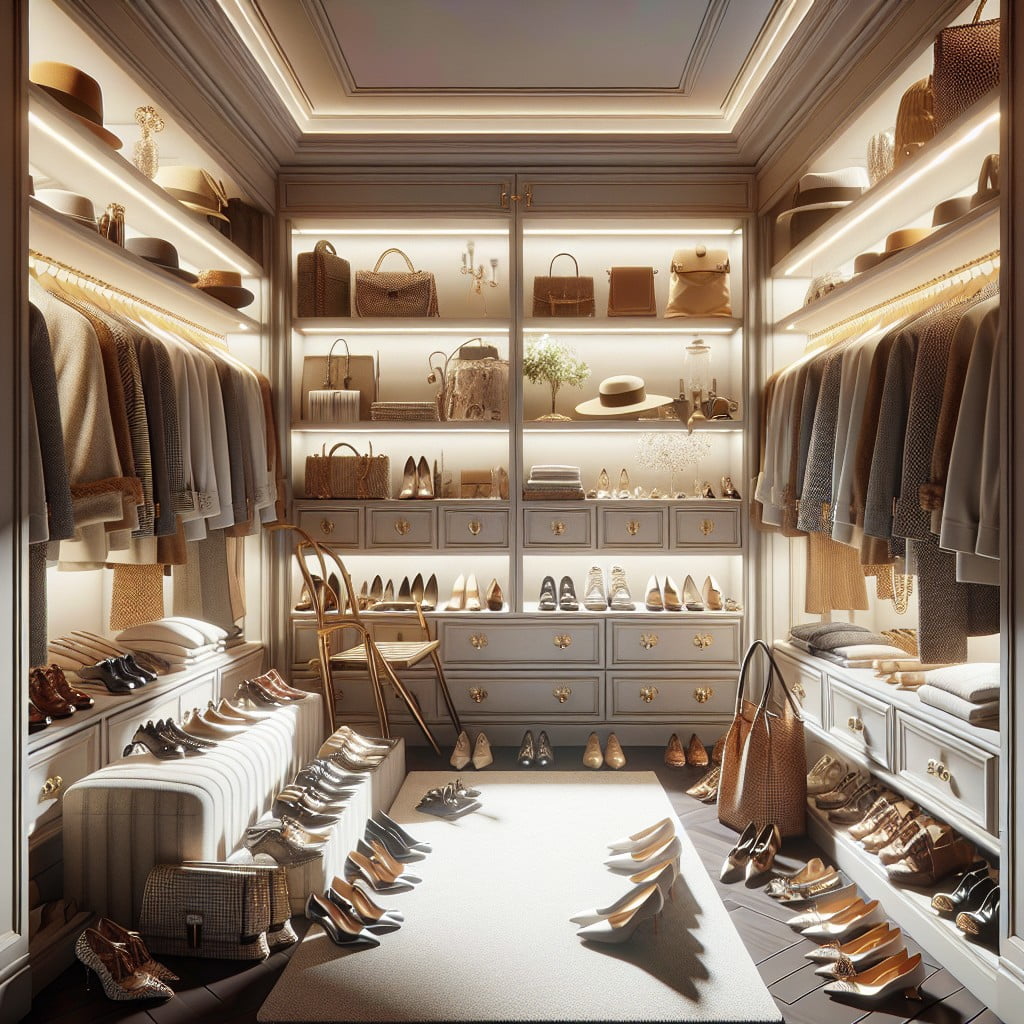
Accenting your outfit with the right accessories can make all the difference, and how you store them can be just as important. Open closets allow for a creative and attractive display, turning your belts, jewelry, hats, and bags into decor.
Consider these tips:
- Utilize decorative hooks or small racks to hang necklaces and bracelets for easy visibility and to prevent tangling.
- Feature your favorite pieces using standalone jewelry trees or trays that add a touch of elegance.
- Install shallow shelves for clutches and sunglasses, keeping them within reach yet orderly.
- Opt for clear storage boxes for watches and miscellaneous items, which doubles as a neat way to showcase them.
- Intertwine functionality and style with unique display cases or vintage dishes for your cherished pieces.
- For a cohesive look, choose a consistent color scheme or material that complements your bedroom’s decor.
By turning your accessories into part of your room’s aesthetic, not only do you appreciate them more, but you also streamline the selection process when putting an outfit together.
Choosing the Right Open Wardrobe System
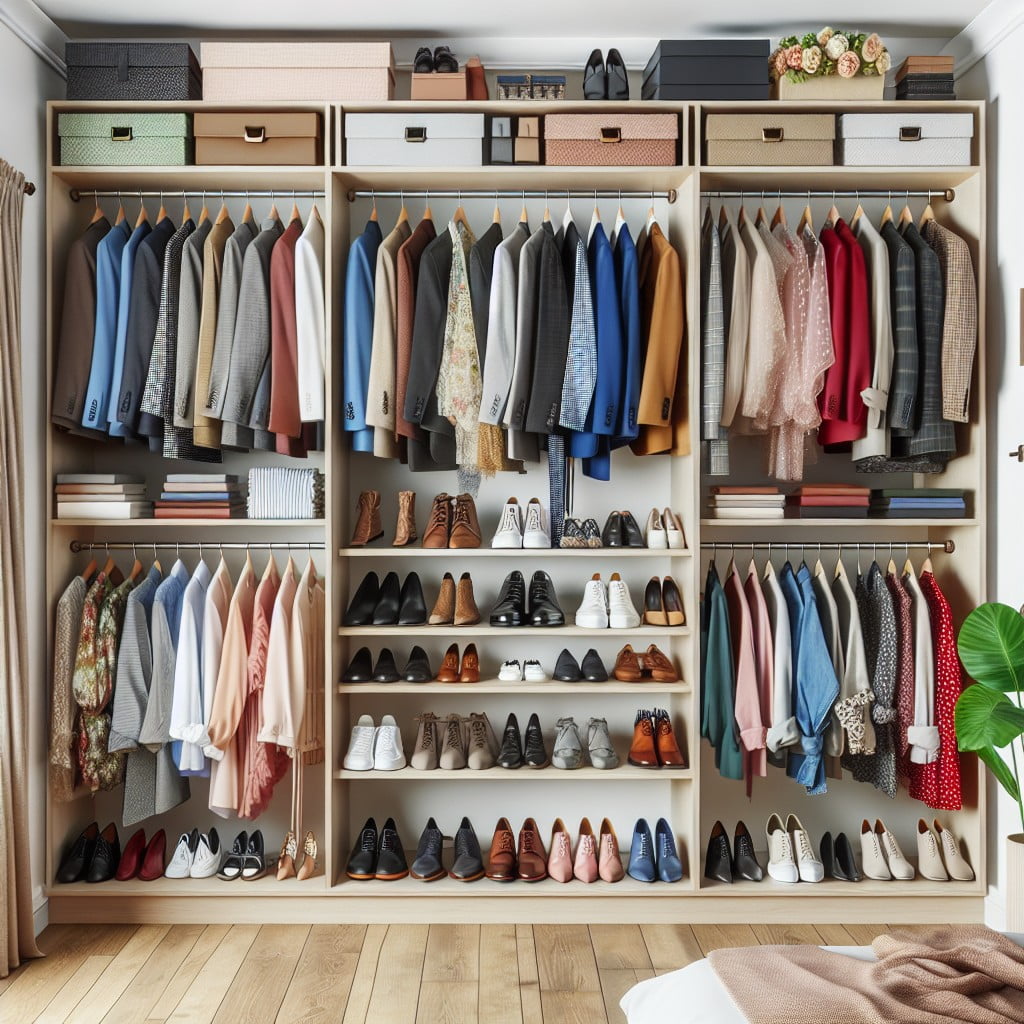
When deciding on an open wardrobe system, consider the size and layout of your space. Smaller rooms benefit from a vertical design, making use of height rather than floor area. Conversely, expansive spaces can accommodate wider units or even a series of sections to categorize clothes by type or season.
Materials matter both for aesthetics and longevity. Metal systems offer durability and an industrial look, while wood brings warmth and a natural feel. For flexibility, mixed materials can provide the benefits of both.
Assess what you’ll store to ensure the system matches your needs. If you have numerous dresses or coats, prioritize a setup with ample hanging space. For a shoe enthusiast, seek options with dedicated shoe storage.
Check weight capacity to avoid overloading, which can compromise stability and safety. Systems with adjustable features allow for future changes to your wardrobe or room.
Finally, consider integration with other storage solutions in your room to create a cohesive look. Matching the color and style of your open wardrobe with other furniture contributes to a well-curated space.
Maintaining an Open Closet
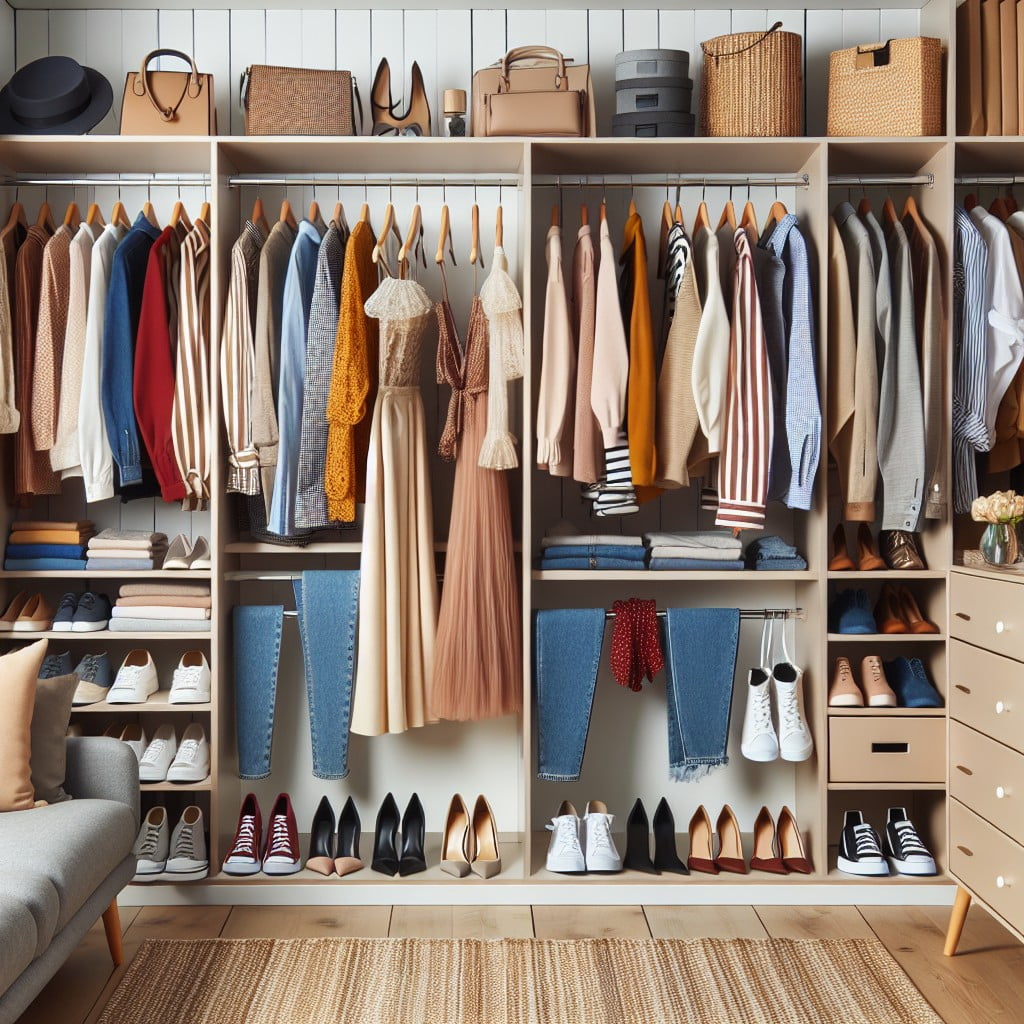
Regular decluttering ensures that your space remains manageable and visually appealing. Set aside time each season to sift through items, keeping only what you use and love. This not only keeps your wardrobe current but also makes it easier to find things.
Prioritize cleanliness by wiping down shelves and rods weekly to prevent dust accumulation. If possible, incorporate materials that resist dust and are easy to clean, such as metal or polished wood.
Organize clothing by category, color, or frequency of use to maintain order and ease of access. This visual segmentation not only adds to the aesthetic but also simplifies your routine.
Use consistent hangers for a cohesive look and to treat clothes gently, avoiding hanger marks or damage. Investing in quality hangers can prolong the life of your garments.
Introduce baskets or decorative boxes for smaller items that tend to clutter, like scarves, belts, or socks. Such containers conceal messes and contribute to the overall tidiness.
Ensure everything has its place to discourage random piles from forming. The open nature of the closet means every item is on display, making systematic organization paramount.
Incorporate fresheners or sachets to keep the area smelling pleasant and to protect against moisture and pests that can damage clothes. This step is often overlooked but crucial for an open closet setup near high-humidity areas such as laundry rooms.
Organizing Open Closet Systems
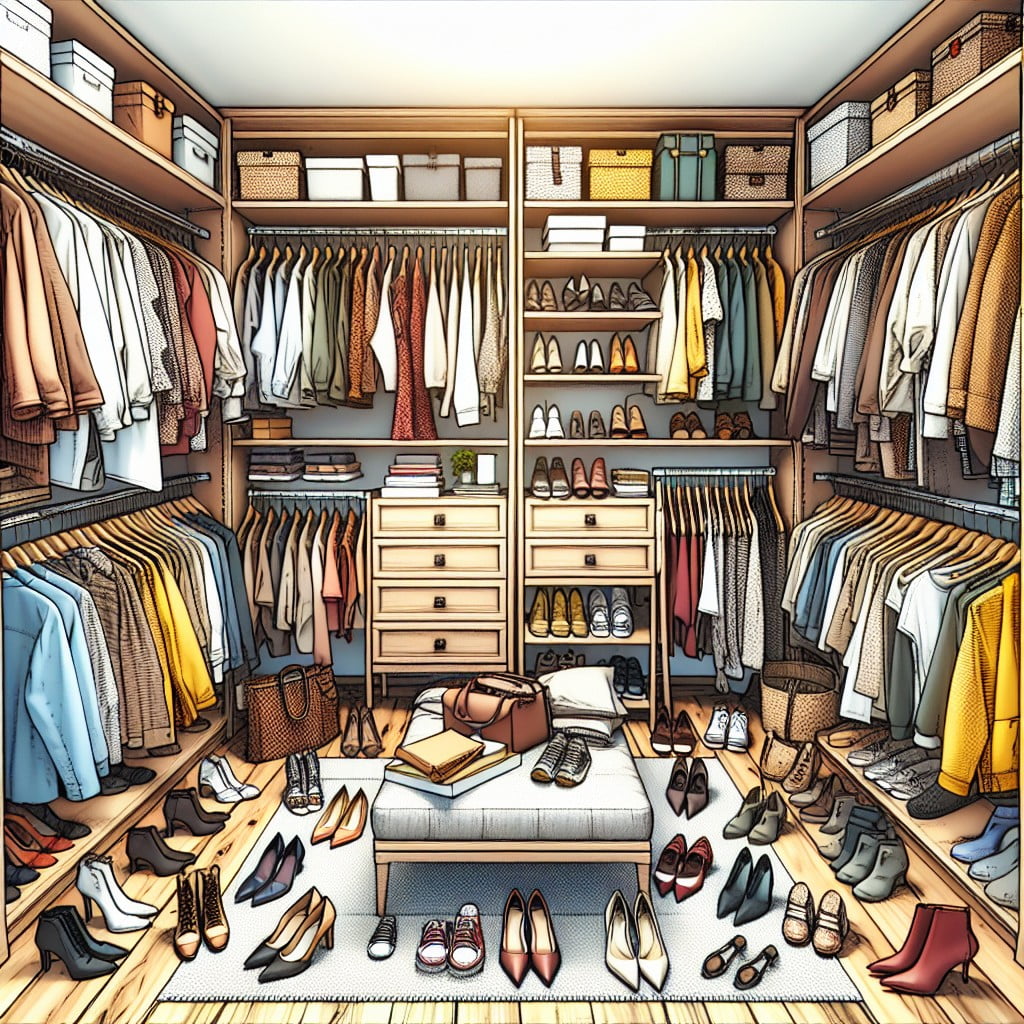
To maintain both function and aesthetics in an open closet, consider these organizing strategies:
- Group clothing by category: Arrange items such as shirts, pants, and dresses together for easy access and an orderly appearance.
- Employ color coordination: Sorting clothes by color not only looks pleasing but also makes it easier to find what you’re looking for.
- Use uniform hangers: A consistent hanger style creates a streamlined visual effect and can help optimize space.
- Incorporate baskets and bins: These are perfect for corralling smaller items like scarves or belts and can be labeled for added convenience.
- Dedicate zones for different items: Assign specific areas for work wear, casual clothes, and formal attire to simplify the decision-making process when choosing an outfit.
- Keep seasonal items accessible: Rotate clothes based on the season, storing off-season garments out of the way to reduce clutter.
- Fold knitwear and delicates: To prevent stretching, neatly fold sweaters and sensitive fabrics and place them on shelves or in designated storage boxes.
By implementing these methods, an open closet can remain tidy, making it a functional and stylish part of your living space.
Multifunctional Open Closet Solutions
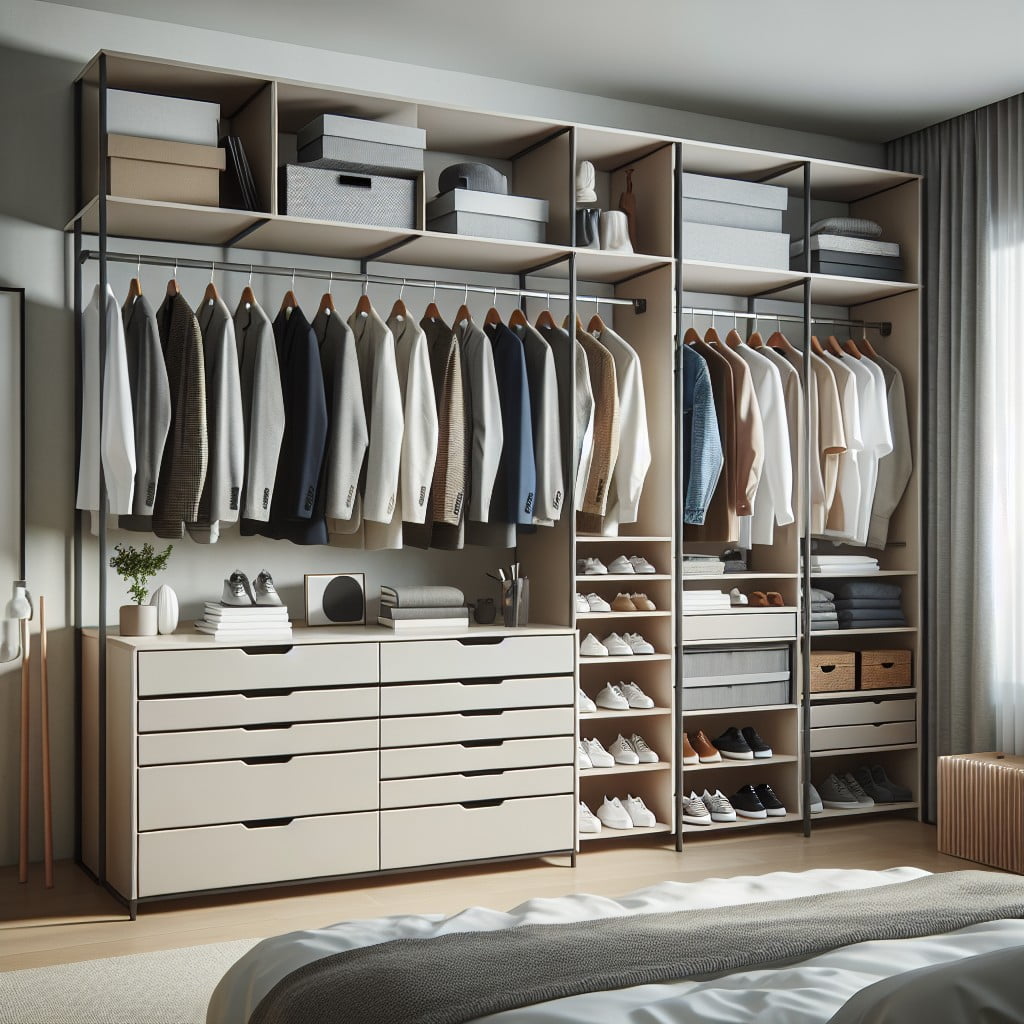
When space is at a premium, a multifunctional open closet serves as more than just storage for clothing and accessories. Integrated desk space can transform an area of the closet into a compact home office, perfect for small living quarters. By placing a sleek desk alongside hanging garments, you create a dual-purpose zone that maximizes functionality without sacrificing style.
Incorporating a bench that doubles as both seating and a storage unit lets you have a spot to sit and get ready, with additional room below for stashing shoes or baskets of items. This solution can be especially useful in entryways or at the foot of a bed in smaller bedrooms.
For those who love displaying their fashion as artwork, an open closet can also function as a room divider, creating a visual separation in studio apartments or loft spaces while keeping your wardrobe accessible.
Lastly, consider adding a pull-out ironing board that tucks away when not in use to maintain the sleek look of the open design while providing practical utility. By thinking creatively, your open closet solution can transition seamlessly between a variety of needs, ensuring your space remains uncluttered and stylish.
FAQ
What is an open closet called?
An open closet is also referred to as a doorless closet.
Are open closets a good idea?
Open closets can be a great idea because they are becoming a popular wardrobe storage option suitable for any room size.
What is open closets vs closed?
Open closets are ideal for larger spaces, essentially transforming a room into a "mini boutique" for clothes storage, while closed closets, commonly found in most homes, are easier to maintain and should be chosen based on their fit to your lifestyle.
How can one effectively organize an open closet?
One can effectively organize an open closet by categorizing items, employing vertical space, utilizing storage boxes and bins, opting for uniform hangers, and frequently decluttering.
What are the pros and cons of implementing an open closet design in bedrooms?
Open closet designs can maximize storage space and add aesthetic appeal, yet they might increase clutter and dust collection.
Are there specific materials recommended for building open closets?
Popular materials for building open closets include solid wood, particle board, and metal for durability and aesthetic appeal.
Recap:
